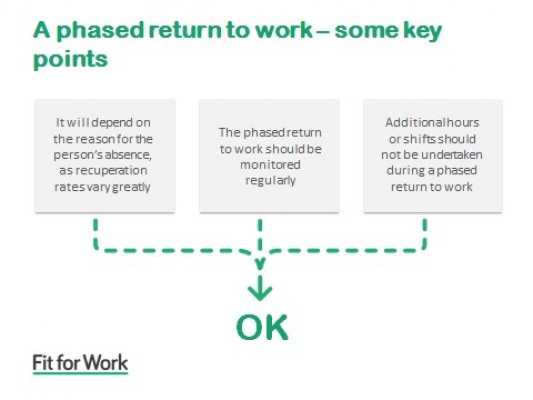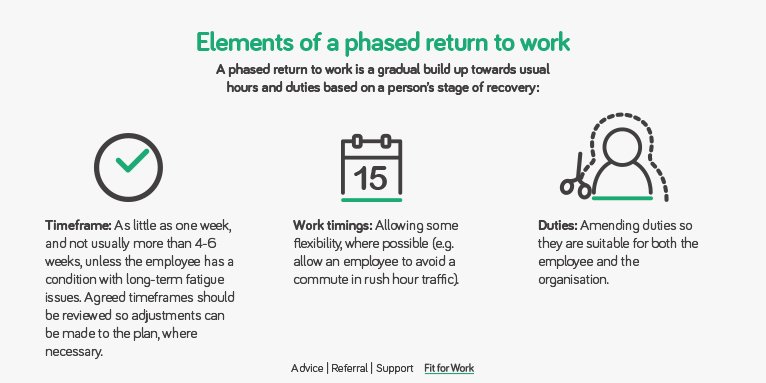Dig into Ultimate Phased Return to Work Guidelines

posted:3 years agobyMarry JoJoin Work Life
Phased return to work is a concept that every employee needs to understand. This concept unlocks vital details about an employee who would get back to work after a long illness. In this article, I would describe every single detail of Phased return to work. So, let's get started.
What is a Phased return to work?
When an employee is absent from work for a prolonged period (more than four weeks), the government requires the employer to consider a phased return to work. Occupational health or the doctor of an employee can issue a fit for work note. According to this, an employer will make necessary adjustments to the work schedule, duties, and arrangements so that that employee can resume his work activities.

I know the whole concept seems a bit complicated. So, here is a simple form of a phased return to work plan example.
Let's suppose you are an employee who is absent from his work due to an accident and injury. It has been more than four weeks. Your absence causes many problems at work. Instead of hiring your replacement, the employer decides to make some changes in your job, such as:
- Changing work hours - Instead of working from 9 to 5, you can work from 9 to 1.
- Changes in your job duties: Instead of working on multiple tasks, you are assigned to manage a few.
- Changes in your work arrangements - Instead of coming to the office, you can continue working from home while lying on your bed.
What are the Benefits of Phased Return to Work for an Employer?
Here are some reasons why an employer agrees to make some changes in work duties and hours for a sick employee.
- Keeping a Valuable Employee: Some employees show remarkable performance at work. You can't easily find their replacement. You can save a valuable employee by going with this option.
- Positive Work environment: If an employer makes adjustments in a sick employee's work duties, it creates a positive work environment. It will leave a good impact not only on sick employees but also on other employees. They would know that if something goes wrong, then their employer will be there to help them.
- Money-Saving: An employer needs to bear recruitment costs, but he can save that money by keeping his existing employee. Covering an absent employee's cost is always an expensive option, which an employer can eliminate quickly through a phased to return option.
Find out: How to Call in Sick at Work
Who can Request Phased to Return?
Both employee or employer can request phased to return.
- When an employee is sick for a prolonged period, he will lose a sense of purpose in his life, especially when he has to stay all day long at home. Therefore, he would ask his general practitioner GP to write a fit note. On this note, the doctor will mention what an employee can do and what things he needs to avoid to speed up his recovery. The employee would take that fit note to the employer and ask him to initiate a phased to return process,
- On the flip side, if an employer doesn't want to hire a replacement and let his employee work during his recovery, he would ask an occupational health practitioner to assess his employee. Once OHP would assess an employee's health, he would suggest to the employer whether an employer is fit for work or not.
Understand Phased Return to Work Process
As I told you before, both employee and employer can make a phased return request. Once a request is made, the next step is discussion.
The employee will sit with his Line manager and Human Resource team, and then he would explain what kind of arrangements would make him get back to work while causing no obstacles for his recovery.
An employer would listen to the employee's suggestion, and then he would create a phased return plan. Typically, the whole procedure is dependent on employee absence policy and also employee handbooks. It's a good practice for an employee to check his employee handbook to find out more about his company's policy for absence and return back to work after illness procedure.
The HR team will create a proposal after the discussion. An employee would agree to this proposal terms and conditions. Throughout this phase, the Line manager and HR Team will check the progress of employee's work and duties and then make changes after mutual agreement.
Step No. 1 Written Request of Phased to Return either from Employee or Employer.
Step No.2 Discussion between Employee and HR/Line Manager
Step No.3 Proposal from Employer
Step No.4 Acceptance of Proposal
Step No.5 Resuming work duties
Step No.6 Review and changes
Phased to Return Plan Examples
You need to understand that this plan depends on the employee's circumstance and the nature of his job role. Here are some examples that would give you an idea of the Phased to Return Plan for a sick or injured employee.

A plan of phased return is designed for an individual staff who is returning to work after a long-term absence. This plan will help that specific employee resume his work activities gradually while dealing with his recovery process.
Alternative Duties
According to a general practitioner, an employee can handle only light duties during the recovery phase. In that case, if an employee works as a machine operator or as a weight lifter, employers would ask him to do office duties as an administrative assistant. The changes in duties let employees continue working at their own pace. This alternative duty becomes a part of the plan, and the employer will set terms and conditions after discussing them all with the employee.
Hours Adjustment
Another plan of phasing to return could be changed in work hours. An employer can get back home during busy hours after working either in the morning or evening shift. At first, the working hours will be reduced. Later on, employers would start increasing work hours while employees would have a complete idea of this increment. This plan can also be a staged return, where stage one involves fewer hours and further stages will have more hours.
Reasonable adjustments
General Practitioner will make it clear on fit to return to work note that at what capacity an employee can work. An employer would make a plan after considering this note and also some suggestions from his employee. He would agree to make reasonable adjustments at work; however, the area of what is reasonable is based on the employer's discretion. Suppose an employee thinks that his job adjustments aren't reasonable. In that case, he can approach an employment tribunal that will judge the whole terms and conditions once an employee makes a claim against the employer.
Legal Side of Returning Back to Work After Illness or Injury
There are some legal and health implications for both employee and employer who permits phased return. If an employee resumes his work after disability, then an employer can't dismiss an employee because he can't understand his work.
According to Law, an employer needs to seek some alternative employment opportunity internally for that employee at the workplace.
Another important thing is the risk assessment of an employee. Before reintroducing an employee to the workspace, an employer should conduct a risk assessment to determine whether an employee is fit enough for the workplace.
An employee's sickness, injury, or accident may have altered his ability to work in a particular environment, making employees more vulnerable to accidents at work. Through risk assessment, an employer would ensure that the employee doesn't face any such situation.
Phased return to work after absence due to stress
When an employee is on sick leave due to stress, he has a disability under the Equality Act 2010. According to this act, any mental or physical condition with a significant or long-term effect on your ability to continue normal activities is a disability. If an employee has taken sick leave due to stress, it's essential that an employer has to make reasonable adjustments for his employee.
A line manager and HR manager needs to tackle this situation as it's a sensitive one. An employee might seek adjustment not only in the work hours but also in the location. It's better to discuss every matter with an employee.
A good phase to return plan while dealing with a stressed employee is to offer him a quiet place to work. The purpose is to calm down his mind and let him blend with the workplace. The first stage of the plan is to change his location to feel distracted or over-stressed. In this stage, the load of work needs to be reduced as well. So, he doesn't handle stress due to too much work. In later stages, you can change his location and make him sit alongside his colleagues.
A meeting between the HR manager and employee is a must. During this meeting, an employee would define his work condition, location, and tasks. An employer will have to be flexible for locations, administrative burden, and related job things.
Is a risk assessment needed?
Yes, an employer needs to conduct a risk assessment of an employee's health and safety. He needs to keep a full record of this assessment. A written copy of the assessment is required. It will be reviewed and updated periodically. When an employee gets back to work after physical and mental disability, the employer would speak to him to understand the workplace's risks.
When an employee returns to work after illness and is fully recovered, an employee won't need a risk assessment. Instead, it's a better idea that an employer would support him in making a smooth transition from part-time to full-time work.
Phased return to work after maternity leave
When a mother gets back to work after one year, then phasing to return would help her readjust to working life. During this process, practitioners would settle a baby in childcare routine. Besides, babies and mothers need to adjust to the new pattern of breastfeeding. Both employer and employee need to decide whether the employee will get paid when they are not at work. An employer should mention pay details of maternity leave in the employee handbook so that other staff could consider it a fair treatment.
How to Re-Enter Workforce After Long GAP
Does a phased return to work affect pay?
Employees always want to know about the phased return to work pay. You should know that pay and salary during this phase depend on circumstance and your employer.
First Option
If your employer is generous, he won't mind paying full pay once an employee commences phased to return.
The first option is always delightful for employees. However, not every employer can afford to pay full employment during the phase to return. It's an excellent incentive to keep employees motivated at work during his recovery process, though.
Second Option
Another situation is when an employer would pay only for the working hours and top-up the rest of the time with Statutory Sick Pay (SSP)
An employee needs to be entitled to SSP. An employee is qualified for this pay only when an employee is absent for four consecutive days. For example, when an employee works on Monday and Thursday, he won't be entitled to SSP. However, when he works on Monday and Tuesday, he can get SSP for four consecutive holidays of the week.
Third Option
Some employers only make payment of working hours during top-up the rest of the time with Occupational Sick Pay.
Many companies have an Occupation Sick Pay scheme. An employee needs to be entitled to that scheme for getting his top-up pay from the employer. An employer can pay OSP to an employee for the hours or week they are absent from work during the phased to return process. An employer needs to explain everything clearly in this scheme. According to the general scheme, an employee receives full pay for three months and a half pay after three months.
Explore: Tips to Nail an Interview
